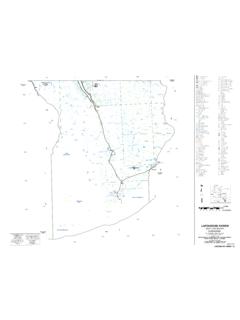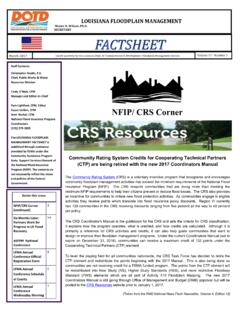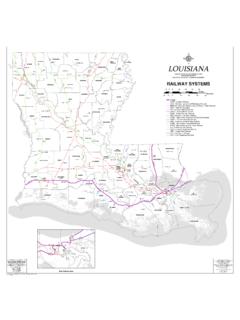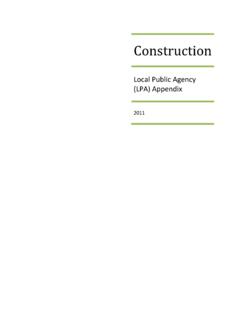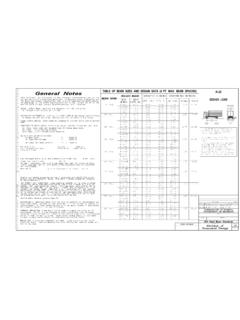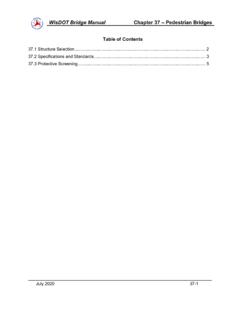Transcription of ELEMENTS OF DESIGN - Louisiana
1 ELEMENTS OF DESIGN 4-1. CHAPTER 4. ELEMENTS OF DESIGN . SIGHT DISTANCE. The ability to see ahead is of utmost importance for safe and efficient operation of a highway vehicle. Sight distance can be defined as the length of highway visible to a user of the highway. The four types of sight distances discussed in this chapter are: Stopping Sight Distance: the distance required for a vehicle to stop once the driver sees the object necessitating the stop. Passing Sight Distance: the distance required to pass a vehicle (applicable only to two-lane highways). Decision Sight Distance: the distance needed to make complex or instantaneous decisions, where information is difficult to perceive or when unexpected or unusual maneuvers are needed. Intersection Sight Distance: the distance provided when feasible at intersections to enhance the safety of the facility.
2 See Chapters 3 and 9 of the aashto Green Book for more information on sight distance calculations. Stopping Sight Distance Stopping Sight Distance (SSD) is the length of roadway required for a vehicle traveling at or near the DESIGN speed to stop safely before reaching a stationary object in its path. As outlined in Chapter 3 of the aashto Green Book, calculations are based on: height of driver's eye ( ft above the road surface). object height (2 ft above the road surface). the passenger vehicle as the DESIGN vehicle wet pavement conditions Adjustments to the calculated lengths should be made if the roadway is on a significant grade, as defined in Chapter 3 of the aashto Green Book. Passing Sight Distance Passing Sight Distance (PSD) is the length of roadway required for a vehicle to safely complete a passing maneuver.
3 Lengths are calculated based on the passenger vehicle and an object height of ft, equivalent to the height of the standard passenger vehicle. March 2022. ELEMENTS OF DESIGN 4-2. When setting the horizontal and vertical alignment on a two-lane project, it is essential for the designer to provide as many areas as possible for safe passing maneuvers. If the horizontal and/or vertical alignments do not allow adequate length for passing, the use of passing lanes may be considered, as discussed in Chapter 3 of the aashto Green Book. Decision Sight Distance Decision Sight Distance (DSD) is the distance required for a driver to: 1. Detect an unexpected or difficult-to-perceive information source or hazard in a roadway environment. 2. Recognize the hazard or its threat potential. 3. Select an appropriate speed and path.
4 4. Safely initiate and complete the required maneuver. Adequate stopping sight distance will be provided at all points along the highway. The designer can further enhance the safety of the facility by providing distances at spot locations sufficient for a driver to negotiate the steps above. Decision sight distance is usually considerably longer than SSD. The designer should use engineering judgment to determine where decision sight distance should be provided on a highway, keeping in mind DESIGN constraints such as right-of-way and environmental impacts. Chapter 3 of the aashto Green Book contains additional discussion of decision sight distance. Intersection Sight Distance Intersection Sight Distance (ISD) is the distance that allows a driver stopped at an intersection to: travel across the intersecting roadway by clearing traffic to both the left and the right of the crossing vehicle turn left into the crossing roadway, by first clearing traffic to the left, and then enter the traffic stream with vehicles from the right, with minimal effect on the speed of oncoming traffic turn right into the intersecting roadway by entering the traffic stream with vehicles from the left, with minimal effect on the speed of on-coming traffic Adequate stopping sight distance will be provided at all points along the highway, including intersections.
5 By providing distances at intersections sufficient to meet the three criteria above, the designer can further enhance the safety of the facility. As with DSD, intersection sight distance is usually considerably longer than SSD. It may not always be practical to provide intersection sight distance due to other constraints, such as right-of-way impacts, environmental concerns, etc. Intersection sight distance is based on an eye height of ft and an object height of ft. Chapter 6 contains additional discussion of intersection DESIGN and Chapter 9, Section of the aashto . March 2022. ELEMENTS OF DESIGN 4-3. Green Book contains additional discussion of intersection sight distance and procedures for calculating distances. HORIZONTAL ALIGNMENT. The location and alignment selected for a highway are influenced by factors such as physical controls, environmental considerations, economics, safety, highway classification, and DESIGN policies.
6 The horizontal alignment cannot be finalized until it is coordinated with the vertical alignment and cross sectional ELEMENTS of the roadway. DOTD typically uses horizontal curves for all deflections in an alignment. However, in special situations, such as roadway reconstruction on an existing alignment, angles with deflections less than or equal to 17-minutes (0 17') are allowed with no horizontal curvature. Chapter 3, Section of the aashto Green Book lists additional considerations in setting horizontal alignments. Types of Curves 1. Circular Curves: DOTD typically uses the arc definition of the circular curve. Under this definition, the curve is defined by the radius or by the degree of curve (D ), which is the central angle formed when two radial lines at the center of the curve intersect two points on the curve that are 100 ft apart, measured along the arc of the curve.
7 Additional circular curve information and formulas are shown in Figure 4-01. 2. Compound Curves: For open highways, compound curves between connecting tangents should be used only where existing topographic controls make a single simple curve impractical. When compound curves are used, the radius of the flatter curve should not exceed the radius of the sharper curve by more than a ratio of :1. (see Figure 4-02). A ratio of 2:1 is allowed on turning roadways, such as interchange ramps, where compound curves are more common. This criterion only applies when going from a flatter curve to a sharper one. Therefore, on one-way roadways, the ratio may be exceeded when going from a sharper curve to a flatter one in the direction of travel. 3. Reverse Curves: Any abrupt reversal in alignment should be avoided.
8 A reversal in alignment can be suitably designed by including a sufficient length of tangent between the two curves to provide adequate superelevation transition lengths (see Figure 4-03). See Section for additional discussion of superelevation transition lengths. For roadways with DESIGN speeds less than 45 mph, a minimum tangent of 100 ft should be provided between reverse curves, even if superelevation is not required. On higher speed roadways, curves that do not require superelevation are so flat that no tangent between the curves is necessary. Where roadways are located alongside bayous and levees, the meandering character and physical constraints of these features make it impractical to completely eliminate all reverse curves separated by short tangents. DESIGN waivers may be warranted in such cases.
9 March 2022. ELEMENTS OF DESIGN 4-4. 4. Spiral Curves: Spiral curves are not used, except in special cases. For overlay or widening projects, spirals are permitted to remain. For roadways to be re-constructed, spiral curves are replaced with simple curves, unless existing property improvements or other controls make this impractical. 5. Broken-back Curves: Successive curves in the same direction that are separated by a short tangent are known as broken-back curves (see Figure 4-04). DOTD defines this short tangent as one with a length less than 15v, where v is the DESIGN speed in mph. Broken-back curves are undesirable from an operational and appearance standpoint. If possible, every effort should be made to avoid this type of alignment by separating curves in the same direction with a minimum tangent length of 15v or by a desirable length of 1500'.
10 As noted in No. 3 above, it may not be feasible or practical in some situations to completely eliminate broken-back curves. 6. Curves with Small Deflection Angles: A short horizontal curve with a small deflection angle (less than 5 ) may appear as a kink in the roadway. Where appropriate, this undesirable appearance can be avoided by using curve lengths in excess of that computed by: L = 1000 - (100) (Delta). where: L = curve length in feet Delta = deflection angle in degrees 7. Minimum Length of Horizontal Curve: The minimum length of horizontal curve required on highways should be Lmin=15v (where v is the DESIGN speed in mph). For new construction and reconstruction projects on local roads and streets, the designer should attempt to provide minimum lengths of at least 500 ft. However, longer curves than those specified above may be necessary in order to provide a minimum of one- third of the curve in full superelevation.


